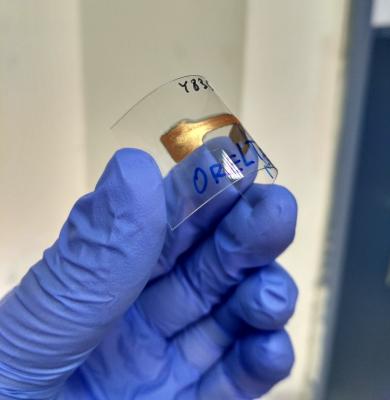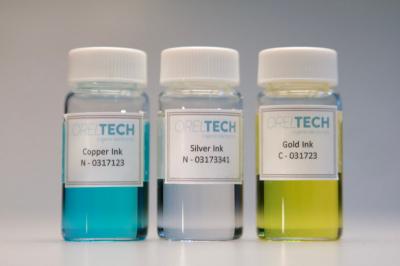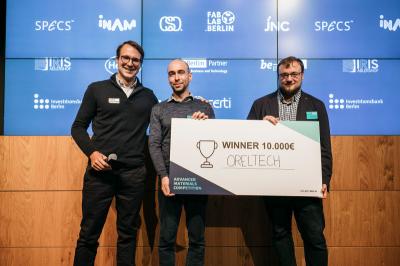 OrelTech is an Israeli-based early stage company that commercializes a unique printed electronics technology based on novel conductive ink and production process.
OrelTech is an Israeli-based early stage company that commercializes a unique printed electronics technology based on novel conductive ink and production process.
OrelTech's Head of R&D, Konstantin Livanov, was kind enough to explain the company's technology and business. Dr. Livanov received his PhD in chemistry from Weizmann Institute of Science, and his expertise is in surface chemistry, nanomaterials, composite materials and electron microscopy.
Q: Hello Dr. Livanov, thank you for your time. First, can you explain ORELTech's process and technology?
Sure. We are doing conducive ink for advanced applications in printed electronics. The advantages of printed electronics are obvious: drastically reduced manufacturing costs due to simpler equipment, fewer fabrication steps and shorter throughput time. However, most organic devices, including OLEDs, are not printed. We could however print them if we could print metal layers at low temperatures. Right now most of them are assembled or deposited in high vacuum.
Nanoparticle based inks enable metal printing but they offer limited solution that is applicable only to certain devices: touch sensors, RFID tags, some printed circuits and backplanes. However, high curing temperatures makes them incompatible with advanced applications like sensors, OLEDs and OPV cells. That is a well known problem and it created a bottleneck for the printed electronics industry for the last decade.
That is where OrelTECH technology comes in.
Our team of scientists, alumni of Weizmann Institute of Science in Israel, have solved this problem by using combination of ionic ink and cold plasma curing. The process takes just a few minutes and never surpasses 70°C making it compatible with most advanced materials needed for both printed and organic electronics, including OLEDs. So, OrelTech process works at much lower temperature and results in metal layers with conductivity similar to NP-based inks. In addition it brings significant cost reduction: there is no need to manufacture nanoparticles and add large amounts of chemical agents.
Ionic nature of the ink also allows us better control of ink parameters. For example OrelTech ink can be applied on plain paper and amorphous PET using very simple Epson XP-235 office printer that costs less then $50 USD. In addition to inkjet we have developed a solution for aerosol printing and lithography, and we can develop screen printed solution in the future. OrelTech has solutions not only for Silver market but for many different metals including gold. Gold ink is very important for the fast growing field of bio-sensors. High quality gold NP ink is both complicated and expensive to manufacture. This fact, in combination with high curing temperature, enforces the industry to use vapor deposition in biosensor manufacturing.
OrelTech solution costs a fraction of the price, has higher conductivity and can be applied on any sensitive material enabling introduction of printing to the bio-sensor manufacturing industry. The applications of OrelTech metallization goes far beyond printed electronics. It can be used to manufacture smart textiles for fashion, medical and sport applications; shielding fabrics for the defense industry; conductive composites for aerospace, defense and automotive industry; it can be used to metallize 3D surfaces from both outside and inside etc. OrelTech method can be used not only to print conductive layers the method can be used to produce NP-coated surfaces with variable density.
Based on that, by far the most interesting application of the OrelTech method outside the scope of printed electronics is metallization of porous surfaces, such as those required in manufacturing process of catalysts, filters, porous electrodes and capacitor applications.
OrelTech method transforms complicated multistep process to simple 2-step process while preserving the high control of layer formation structure, and can be applied to relevant metals like silver, copper, platinum, palladium and gold.

Q: You are using gold, silver and copper inks. Can you tell us how these inks differ? How should customers choose between these different inks?
The difference between these inks stems mostly from the application. Copper inks are typically used in low-end devices, such as RFID tags. Gold inks are primarily used in biomedical applications due to gold's inert nature. Silver is the go-to metal for most other applications, including OLEDs and sensors, where high conductivity and stability are the most important parameters. In addition, our other inks have applications in catalysts.

Q: Can your process also use organic/carbon inks?
Unfortunately, our process is currently developed only for metals. There is also a possibility of developing a cold metal oxide deposition process using our technology.
Q: When will ORELTech's technology be ready for commercialization?
We want to bring PE products with selected partners to the market by 2020.
Q: What is ORELTech's business model? Do you seek to sell inks and equipment or license your technology?
We are an R&D startup, and are currently focused on R&D collaborations with partners and clients that find our technology interesting. We help them to integrate our technology into their final products. In the future our revenue streams will come from licensing and/or ink sales. In the future our revenue streams will come from licensing and/or ink sales.
Q: ORELTech recently won the first place at the Advanced Materials Competition (AdMaCom) in Berlin, and also won a Henkel innovation award. Can you tell us a bit about that competition and the experience you had there?
We had a wonderful experience. The INAM crew that organized that event excelled in both picking the participants and developing the mentorship program. The whole experience was unbelievably useful for us, both in terms of business connections we made and professional insights we got from the program.

Q: Why was Henkel so excited about your technology?
We believe it was because they saw a potential in a new technology, that is radically different from anything else currently on the market. Maybe they also saw how they can use it in their manufacturing.
Q: We understand that ORELTech is also targeting the OLED market. Where do you see your process being adopted by OLED makers?
We think that our main benefit will be in fully printed OLED devices, since we can print metal contacts without damaging the active materials underneath. We hope to enable bringing top contact devices to the market.
OrelTech is collaborating with a Germany-based startup that develops printed OLED technologies for smart packaging.
Q: How do you see ORELTech's position in the Printed Electronics market in the next 3-5 years?
We believe that our technology would allow introduction of new printed devices to the PE market. We believe that we will be enabling technology for top contact OLEDs, smart fabrics and new generation sensors.
Thank you for your time, Konstantin, I wish both you and OrelTech the best of luck!

